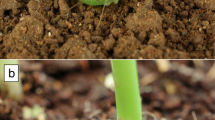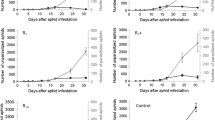Summary
The present paper dealt with the sequential changes of the distribution pattern of apterous females aphid populations, that were artificially settled at the beginning on the experimental barley ‘field’. The aphids were settled at random or even with a fixed denisty per plant. For five or six days after the settling, the number of individuals followed the negative binomial distributions in all cases while the parametersk andp were varying. The estimated values ofk were rather small for the first one week after the settling, which may suggest that the number of moving aphids between plants was relatively small and the degree of concentration expressing the intrinsic increase was high. After that, as the number of individuals increased, the number of moving aphids between plants would be considered to be increased. It was found that with the lapse of time the degree of concentration decreased ork became larger.
The distribution of aphids per blade in a plant was also described briefly.
Similar content being viewed by others
Literature Cited
Anscombe, F. J. (1949) The statistical analysis of insect counts based on the negative binomial distribution.Biometrics,5: 165–173.
Bald, J. G., Norris, D. O. &Helson, G. A. (1950) Transmisson of potato virus diseases. VI. The distribution of the aphid vectors on sampled leaves and shoots.Aust. J. agric. Res.,1: 18–32.
Bliss, C. I. (1958) The analysis of insect counts as negative binomial distribution.Proc. 10th. Int. Congr. Ent. Montreal, 1956,2: 1015–1031.
Bliss, C. I. &Fisher, R. A. (1953) Fitting the negative binomial distribution to biological data and note on the effective fitting of the negative binomial.Biometrics,9: 176–200.
Itô, Yosiaki (1962) Distribution of the overwintering arrow-head scale,Prontaspis yanonensis Kuwana, on the satsuma orange leaves.Jap. J. appl. Ent. & Zool.,6: 183–189.
Kuno, Eizi (1963) A comparative analysis on the distribution of nymphal populations of some leaf- and planthoppers on rice plant.Res. Popul. Ecol.,5: 31–43.
Morisita, Masaaki (1959) Measuring of the dispersion of individuals and analysis of distribution pattern.Mem. Facul. Sci., Kyushu Univ., Ser. E,2: 215–235.
Morisita, Masaaki (1962)I δ-index, a measure of distribution of individuals.Res. Popul. Ecol.,4: 1–7.
Neyman, J. (1939) On a new class of “contagious” distributions, applicable in entomology and bacteriology.Ann. mathem. Stat.,10: 35–53.
Thomas, M. (1949) A generalization ofPoisson's binomial unit for use in ecology.Biometrika,36: 18–25.
Author information
Authors and Affiliations
Rights and permissions
About this article
Cite this article
Shiyomi, M., Nakamura, K. Experimental studies on the distribution of the aphid counts. Res Popul Ecol 6, 79–87 (1964). https://doi.org/10.1007/BF02518808
Issue Date:
DOI: https://doi.org/10.1007/BF02518808




